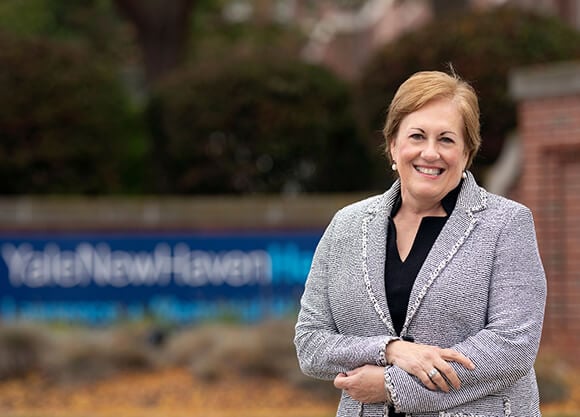
Health care executives share lessons of pandemic
February 10, 2021

February 10, 2021

The event kicked off the inaugural Thought Leaders in Health Care Speaker Series, made possible by a generous gift from Denise J. Fiore ’78, MBA ’91. Her MBA is in health care management. Fiore said she could not have imagined a more appropriate topic than COVID-19 when she began working with QU to bring health care leaders together for inspiring annual discussions.
Connecticut Gov. Ned Lamont joined Quinnipiac President Judy Olian and the following panelists: Marna P. Borgstrom, CEO of Yale New Haven Health; Jeffrey Flaks, president and CEO of Hartford HealthCare; Reginald Eadie, MD, president and CEO of Trinity Health Of New England; and John M. Murphy, MD, president and CEO of Nuvance Health. Janelle Chiasera, dean of the School of Health Sciences, served as moderator.
Olian thanked Lamont and the health care executives for their leadership. “My bet is that none of these leaders would say they have ever been through the breadth and depth of challenges they have had to deal with in the past few months, the widespread assault on every aspect of how they delivered services, secured supplies, called on staff to work in risky conditions, and managed budget and cash flow despite the total upending of business as usual,” she said.
Despite the challenge, Olian said they brilliantly faced and dealt with the “here and now” while approaching the future with what she called gutsiness and the realization that they must innovate in order to survive and thrive.
Connecticut also moved quickly. “The first thing we did,” Lamont said, “was to reach out to our amazing health care providers. We were on the phone every day, and you guys were invaluable.”
“We don’t wear individual uniforms at a time like this; we wear the same uniform, we are on the same team,” Flaks said. He noted that while people harbor an understandable desire to return to normal, he hopes the health care system never does.
“We are going to be better than normal,” he said, citing advances in infection control knowledge and in leveraging telehealth.
“We went from 400 telehealth visits a month to well north of 300,000,” Flaks explained, adding that people in remote parts of the state now have access to specialists.
Hartford HealthCare also added a 24-7 hotline that has logged more than 166,000 calls since March. Flaks also acknowledged that the pandemic amplified the issue of health care equity and disparity. “Massive change has to occur. The statistics during this crisis are startling,” he said.
Murphy talked about the emotional burden on hospital staff—the shortage of PPE and their fear of becoming sick themselves and infecting family members. In response to these concerns, his team instituted peer counseling that he said proved remarkably effective in helping each other get through the crisis.
Borgstrom concurred. At one point, she said, Yale Health had upward of 800 COVID patients. She recalled one nurse saying that staff will live with the emotional effects of what they witnessed for a long time.
Chiasera asked Olian and the health care executives to reflect on their initial decision-making when the crisis emerged.
Quinnipiac, for its part, decided to protect the greater community by not letting students return from their homes to retrieve possessions left behind when the university transitioned to online learning last March, Olian said. “If we had allowed an influx of 10,000 kids from everywhere, that would have put a burden on health care systems,” she said.
For Murphy, the question of what he might do over “is more important than the answer.” Back in March and April, he said life and death decisions were made in real time.
“We thought hydroxychloroquine and azithromycin were fabulously effective—they were not; we thought masks were just an option, and guess what, they are not; we thought with warm weather the virus would disappear—it didn’t; we thought kids didn’t get sick — they do.” Yes, much was learned, but he noted, “We are not as smart as we are going to be two months from now.”
From learning that intubating patients early is really not the right thing to do, to discovering the “crushing” emotional toll when patients die without family able to visit them and only medical staff as witnesses, Murphy and his team developed an evolving playbook to prepare for the predicted second wave that came last fall.
The forum also addressed the topic of vaccinations. Eadie, as co-chair of the state’s COVID-19 vaccine advisory committee, said the members were focused on ensuring the safety of a vaccine as well as its appropriate and equitable distribution.
Read more articles in the Winter edition of Quinnipiac Magazine at QU.edu/magazine.
Quinnipiac Today is your source for what's happening throughout #BobcatNation. Sign up for our weekly email newsletter to be among the first to know about news, events and members of our Bobcat family who are making a positive difference in our world.
Sign Up Now